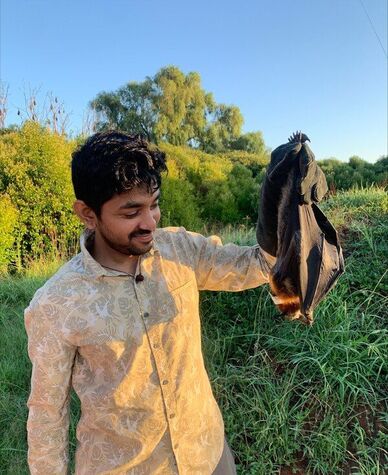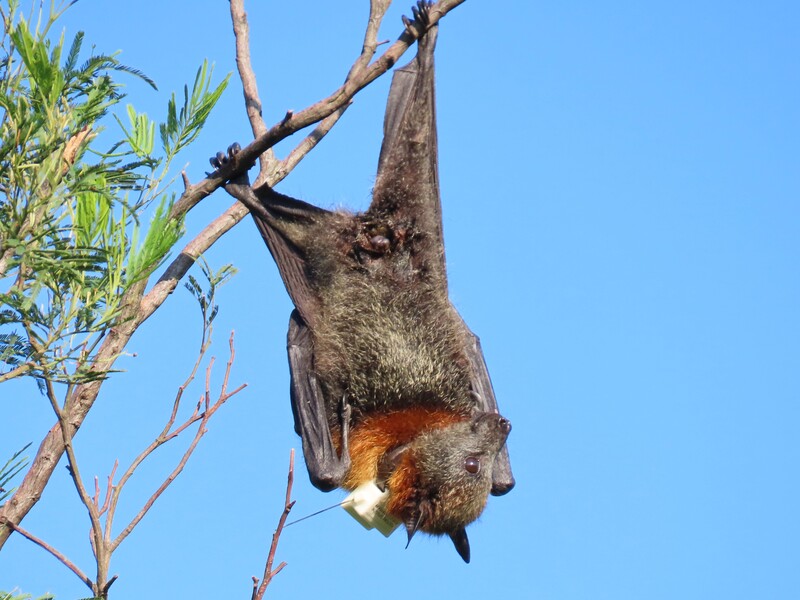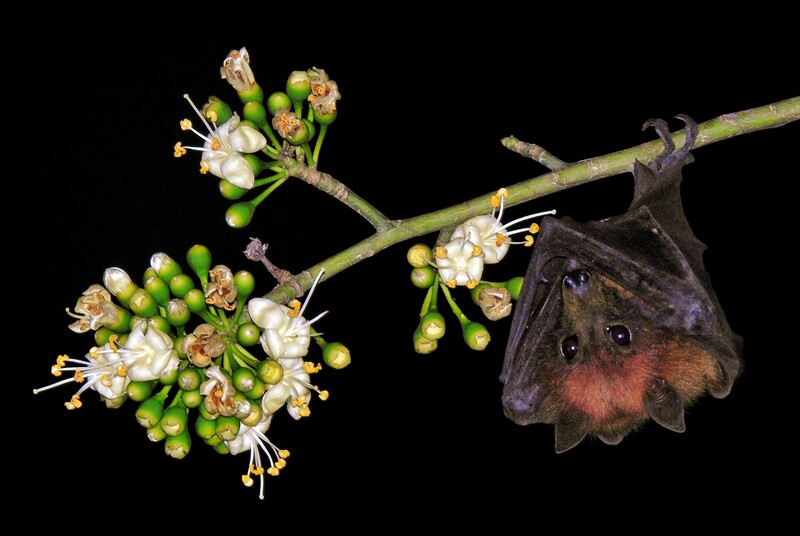Ram Mohan
- PhD Student, Lab of Animal Ecology, Hawkesbury Institute for the Environment, University of Western Sydney
- Topic: A cross-continental comparison of the drivers of flying-fox urbanisation
- Research Umbrella: Flying-fox movement ecology & Flying-fox conservation management
- Supervisors: Prof Justin Welbergen, Dr Jessica Meade & Dr Caragh Threlfall
- Contact: Ram Mohan

Bio
My research interest is primarily in understanding how animals respond to changes in their environment. Over the years, this broad interest has motivated me to explore the fields of behavioural ecology, community ecology, movement ecology and ecophysiology.
During my B.Sc. degree in Environmental Science between 2013 and 2016, I explored opportunities as a research volunteer for monitoring large-mammalian diversity and assessing the bat diversity in the Western-Himalayas. For my M.Sc. project in 2017, I studied diet composition and overlaps between wild mountain goats and domestic livestock in Kashmir part of the Himalayas.
In the following years, I gained valuable research experience in bat community ecology and behavioural ecology. This involved studying variation in the bat species diversity across an elevational gradient in the Western-Himalayas, testing the efficacy of acoustic and olfactory lures to attract neotropical bats into artificial roosts in Panama, and investigating the species assemblages and temporal partitioning of bats over desert ponds in the semi-arid grasslands of the Thar Desert. My research on semi-arid bats inspired me to delve into the field of movement ecology for a PhD, to understand the responses of bats to anthropogenic changes in their environment.
My research interest is primarily in understanding how animals respond to changes in their environment. Over the years, this broad interest has motivated me to explore the fields of behavioural ecology, community ecology, movement ecology and ecophysiology.
During my B.Sc. degree in Environmental Science between 2013 and 2016, I explored opportunities as a research volunteer for monitoring large-mammalian diversity and assessing the bat diversity in the Western-Himalayas. For my M.Sc. project in 2017, I studied diet composition and overlaps between wild mountain goats and domestic livestock in Kashmir part of the Himalayas.
In the following years, I gained valuable research experience in bat community ecology and behavioural ecology. This involved studying variation in the bat species diversity across an elevational gradient in the Western-Himalayas, testing the efficacy of acoustic and olfactory lures to attract neotropical bats into artificial roosts in Panama, and investigating the species assemblages and temporal partitioning of bats over desert ponds in the semi-arid grasslands of the Thar Desert. My research on semi-arid bats inspired me to delve into the field of movement ecology for a PhD, to understand the responses of bats to anthropogenic changes in their environment.

Research
Global urbanisation has had negative impacts on wildlife and their habitat, but new ecological niches afforded by urban environments can be exploited by resilient and adaptable species, a process referred to as ‘biological urbanisation’ . One adaptable faunal group observed to be associated with urban environments are flying-foxes. While anecdotal observations suggest that flying-foxes are associated with urban areas in Asian and Australasian countries, The drivers of flying-fox urbanisation are poorly understood. There is increasing consensus that the urban colonization and the continued presence of flying-foxes in urban areas, are likely to be associated with spatio-temporal changes in the availability of food resources. Urban tree planting initiatives can increase the availability of fruiting resources that flying-foxes depend upon, and introduce non-native tree species that flower at different times of the year, thus potentially increasing the year-round stability of food resources available to flying-foxes. Despite the advantages of occupying urban environments, flying-foxes face challenges in the form of anthropogenic hazards like light and noise pollution, powerline electrocution, and vehicular collision, making urban habitats a potential ecological trap for these species. Nevertheless, urban wildlife exhibits resilience by undergoing behavioural adaptations and evolutionary traits to counter these challenges. Understanding the complexities of biological urbanisation of a species and the associated challenges is crucial for effective conservation management and urban planning. Flying-foxes can serve as an ideal model system to investigate the drivers of urbanisation that the research proposed herein will aim to address using the Indian flying-fox (Pteropus medius) and grey-headed flying-fox (Pteropus poliocephalus) as model organisms.
The objectives of my doctoral research are to:
Global urbanisation has had negative impacts on wildlife and their habitat, but new ecological niches afforded by urban environments can be exploited by resilient and adaptable species, a process referred to as ‘biological urbanisation’ . One adaptable faunal group observed to be associated with urban environments are flying-foxes. While anecdotal observations suggest that flying-foxes are associated with urban areas in Asian and Australasian countries, The drivers of flying-fox urbanisation are poorly understood. There is increasing consensus that the urban colonization and the continued presence of flying-foxes in urban areas, are likely to be associated with spatio-temporal changes in the availability of food resources. Urban tree planting initiatives can increase the availability of fruiting resources that flying-foxes depend upon, and introduce non-native tree species that flower at different times of the year, thus potentially increasing the year-round stability of food resources available to flying-foxes. Despite the advantages of occupying urban environments, flying-foxes face challenges in the form of anthropogenic hazards like light and noise pollution, powerline electrocution, and vehicular collision, making urban habitats a potential ecological trap for these species. Nevertheless, urban wildlife exhibits resilience by undergoing behavioural adaptations and evolutionary traits to counter these challenges. Understanding the complexities of biological urbanisation of a species and the associated challenges is crucial for effective conservation management and urban planning. Flying-foxes can serve as an ideal model system to investigate the drivers of urbanisation that the research proposed herein will aim to address using the Indian flying-fox (Pteropus medius) and grey-headed flying-fox (Pteropus poliocephalus) as model organisms.
The objectives of my doctoral research are to:
- Conduct a systematic literature review on biological urbanisation in faunal taxa, its future scope, and direction.
- Evaluate the patterns in the abundance of P. poliocephalus and their roost sites in relation to changes in landscape-level greenness in urban environments.
- Investigate the diet and foraging strategies by flying-foxes along an urban habitat gradient in Australia and India.
- Understand the responses of flying-foxes to anthropogenic disturbances and threats in an urban environment.
Left: A GPS-collared Grey-headed Flying-fox in Sydney, Australia; right: An Indian Flying-fox pollinating a non-native Kapok tree in an urban area in India
Academic Publications
1. Chhaya. V., Lahiri. S., Jagan. M. A., Mohan. R., Pathaw. N. A., & Krishnan. A. (2021), Community Bioacoustics: Studying acoustic community structure for ecological and conservation insights. Frontiers in Ecology and Evolution, 9: 706445; DOI: https://doi.org/10.3389/fevo.2021.706445
2. Chakravarty, R., Mohan, R., Voigt, C. C., Krishnan, A., & Radchuk, V. (2021). Functional diversity of Himalayan bat communities declines at high elevation without the loss of phylogenetic diversity. Scientific Reports, 11(1), 1-13.; DOI: https://doi.org/10.1038/s41598- 021-01939-3
3. Mukherjee. S. & Mohan. R. (2021), Albinism and Leucism in Free-ranging Snakes Rescued in Gujarat and Tamil Nadu, India. Reptiles & Amphibians, 28(3), 485–487.; DOI: https://doi.org/10.17161/randa.v28i3.15754
4. Mukherjee, S., & Mohan, R. (2022). Observations of nocturnal activity in diurnal Indian snakes. Reptiles & Amphibians, 29(1), 146-147.; DOI: https://doi.org/10.1761/randa.v29i1.16345
5. Mohan R, Chhaya V and Krishnan A (2022). Seasonality and interspecific temporal partitioning in a semiarid grassland bat assemblage. Journal of Arid Environments, 205, 104818.; DOI: https://doi.org/10.1016/j.jaridenv.2022.104818
2. Chakravarty, R., Mohan, R., Voigt, C. C., Krishnan, A., & Radchuk, V. (2021). Functional diversity of Himalayan bat communities declines at high elevation without the loss of phylogenetic diversity. Scientific Reports, 11(1), 1-13.; DOI: https://doi.org/10.1038/s41598- 021-01939-3
3. Mukherjee. S. & Mohan. R. (2021), Albinism and Leucism in Free-ranging Snakes Rescued in Gujarat and Tamil Nadu, India. Reptiles & Amphibians, 28(3), 485–487.; DOI: https://doi.org/10.17161/randa.v28i3.15754
4. Mukherjee, S., & Mohan, R. (2022). Observations of nocturnal activity in diurnal Indian snakes. Reptiles & Amphibians, 29(1), 146-147.; DOI: https://doi.org/10.1761/randa.v29i1.16345
5. Mohan R, Chhaya V and Krishnan A (2022). Seasonality and interspecific temporal partitioning in a semiarid grassland bat assemblage. Journal of Arid Environments, 205, 104818.; DOI: https://doi.org/10.1016/j.jaridenv.2022.104818
Grants and Awards
1. The Rufford Small Grant - October 2019.
The Rufford Foundation, UK
https://www.rufford.org/projects/ram-mohan/acoustics-and-conservation-bats-and-birds-insemiarid-landscapes/
2. Inlaks-Ravi Sankaran Fellowship for abroad internship, 2018.
Inlaks Shivadasani Foundation & Ravi Sankaran Foundation, India
https://www.inlaksfoundation.org/ecology-conservation-field-biology/recipients/ https://inlaksshivdasanifoundationblog.org/home/2018/6/19/rsif-interns-zoya-tyabji-and-rammohan
1. The Rufford Small Grant - October 2019.
The Rufford Foundation, UK
https://www.rufford.org/projects/ram-mohan/acoustics-and-conservation-bats-and-birds-insemiarid-landscapes/
2. Inlaks-Ravi Sankaran Fellowship for abroad internship, 2018.
Inlaks Shivadasani Foundation & Ravi Sankaran Foundation, India
https://www.inlaksfoundation.org/ecology-conservation-field-biology/recipients/ https://inlaksshivdasanifoundationblog.org/home/2018/6/19/rsif-interns-zoya-tyabji-and-rammohan



